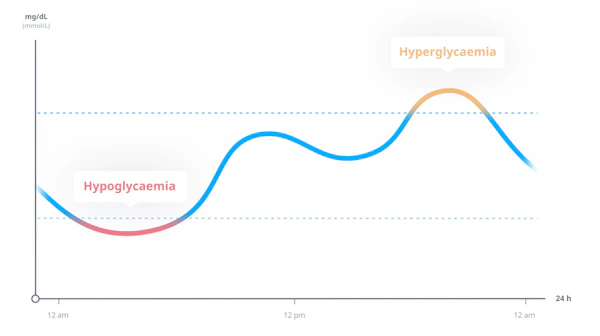Time in Range (TIR) is a new clinical metric that expresses the percentage of time a person with diabetes spends within their target glycaemic range.1 TIR is measured by continuous glucose monitoring (CGM) and may be used with other CGM metrics, including Time Below Range (TBR, which indicates hypoglycaemia), Time Above Range (TAR, which indicates hyperglycaemia), mean glucose, and glycaemic variability to assess a person’s glucose levels. 1-3

Time in Range, a new clinical metric for diabetes management1
The International Consensus Report on TIR recommends that most people with type 1 or type 2 diabetes spend at least 70% of the day (around 17 hours) in the target glycaemic range of 70 to 180 mg/dL (3.9 to 10 mmol/L), which corresponds to the recommended HbA1c target of approximately 7% (53 mmol/mol).1
Clinical guidance and targets for TIR, TBR and TAR, according to the International Consensus Report.1
TIR is a complement to HbA1c, the current gold standard for assessing glucose control.1,2,4 For more than three decades, HbA1c has been relied on as both a diagnostic measure and diabetes management tool for people with diabetes and healthcare professionals.4 Like HbA1c, TIR has also been associated with reduced risk of developing diabetes-related microvascular and macrovascular complications. 5-9 However, while HbA1c measures a person’s average blood glucose levels over the previous two to three months, it does not reflect daily fluctuations.1 Moreover, it does not capture the variable occurrence of hypoglycaemia and hyperglycaemia.1 In fact, two people with the same HbA1c results could have very different glucose profiles.10
An example of two people with the same HbA1c with different glucose profiles.
TIR, together with TBR and TAR, provides a more complete picture of glucose levels and has the potential to reveal patterns of hypoglycaemia and hyperglycaemia throughout the day and night. When used in conjunction with HbA1c, TIR can tell a personalised and individual story about glucose levels, helping people with diabetes to understand both their daily fluctuations and what is driving them, and helping healthcare professionals make more informed decisions for better diabetes management.1